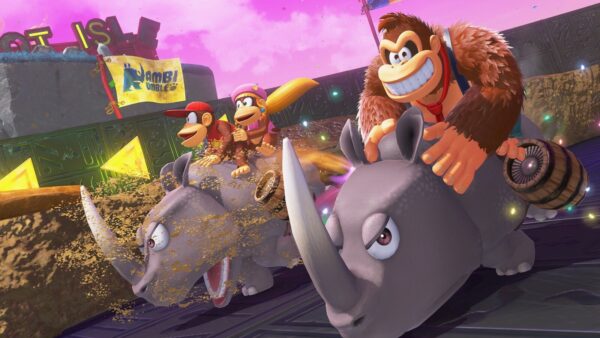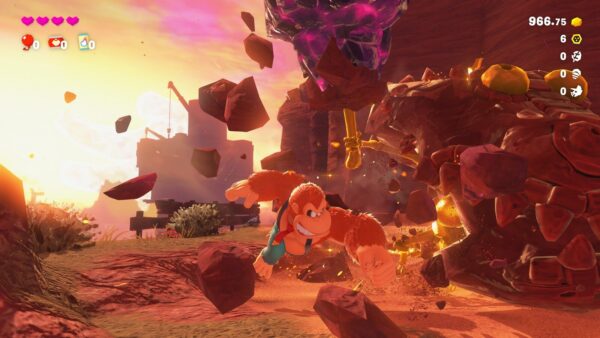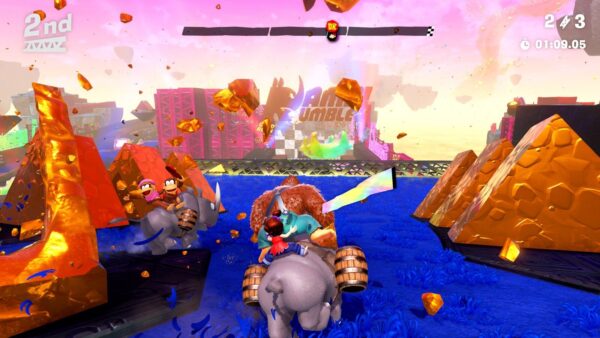It’s been well over two decades since Donkey Kong 64 left Nintendo fans in a collect-a-thon-induced haze, and more than a decade since Tropical Freeze gave us a polished but ultimately safe return to the Country formula.

Since then, Donkey Kong has been living in the Nintendo guest-star lounge, popping up in Mario Kart, cameoing in Super Smash Bros., and occasionally stealing toys in Mario vs. Donkey Kong.
Donkey Kong Bananza changes all of that. This isn’t a side project or a remake. It’s a loud, proud, banana-scented declaration that Donkey Kong is not only back but headlining with a game that feels as much about Nintendo flexing its Switch 2 hardware as it is about reviving a franchise. Crucially, it understands what made the old DK magic work: tactile worlds, satisfying destruction, and a sense that curiosity is rewarded, not punished.
At its core, Bananza is an open-ended, 3D platformer with destructible environments. Think Super Mario Odyssey meets Minecraft but designed by a Nintendo team that’s been quietly biding their time until the tech could match their ambition.
Donkey Kong Bananza
The premise is simple: explore layered environments, collect Banandium Gems, uncover fossils, and switch between Bananza forms: Kong (power), Zebra (speed), and Ostrich (flight) to overcome obstacles.

The twist is how reactive the world is. You don’t just open chests; you smash through walls, topple bridges, and collapse towers to reveal new routes. Every time you think you’ve hit a dead end, the game asks: “But have you tried breaking it?” And on the Switch 2, the destruction is deliciously detailed: bricks tumble, foliage scatters, water sloshes around the debris.
The Bananza forms could have been throwaway gimmicks, but they’re integral. Ostrich lets you glide over hazards; Zebra lets you speed across them and Kong smashes barriers and flips switches. Swapping between them mid-run feels natural, and the costume system isn’t just cosmetic as certain outfits grant buffs that enhance specific forms, giving you a reason to experiment and an incentive to collect fossils.
Bananza’s art direction is a balancing act between retro familiarity and fresh spectacle. The style gives every layer a toybox-like charm, but the lighting, textures, and sheer density of detail scream “new hardware.”
DK’s fur is the obvious showcase, but it’s the little touches: Pauline’s hair, water droplets clinging to leaves, the way shadow creeps across ruins as the day cycle advances that make it feel alive.

Every environment has its own rhythm: bright coastal lagoons where Ostrich glides shine, misty jungle plateaus that demand Zebra agility, volcanic caverns built for Kong’s brute force. The draw distance lets you spot tantalising collectibles long before you figure out the route, a design choice that fuels that itch to “just check one more thing.”
I recently felt this way about Astro Bot on the PS5 and The Legend of Zelda: Tears of the Kingdom on the original Switch. Both are stunning and essential if you own those consoles.
Bananza doesn’t dump everything on you at once. The first few layers feel almost too gentle; a conscious choice to let you get comfortable before the game starts layering in the chaos. Then it hits its stride: massive zones broken up by Country-style 2D interludes, challenge rooms that test specific Bananza forms, and battle arenas that lean into the game’s physics engine.
The bosses are often a delight. Some offer up clever environmental puzzles; others are pure spectacle. Difficulty is forgiving in the main story, but the post-game is unapologetically aimed at veterans, offering layered challenges that demand mastery of every form.

Upgrades matter. Banandium Gems expand your move set, improve stamina, and unlock new form abilities. Fossils unlock costumes with buffs. Revisiting earlier areas with a powered-up DK is rewarding, because the game hides routes you literally couldn’t access before.
Bananza is the kind of game that wouldn’t have worked like this on the original Switch. The widescale destruction, the seamless swaps between large zones, the density of on-screen detail during chaotic moments, all of it relies on the Switch 2’s improved processing and memory.
Loading times are minimal, and the frame rate stays solid even when DK is levelling half a fortress while enemies swarm. I’ve seen reviews lament the framerate drops, but I did not experience any of this, maybe I didn’t push it hard enough.
It’s not just flash for the sake of it. The destruction feeds into exploration, and the richer worlds mean you’re constantly juggling short-term and long-term goals. That loop ‘I’ll just grab that fossil… oh wait, what’s over there?’ thrives because the system keeps up with your impulses. It’s not as pretty as a Ratchet and Clank or Astro Bot, but it never needs to be. The charm remains long after the looks are taken for granted.

The main campaign offers a generous runtime, but it’s the optional content that extends the life. There are dozens of costume-form synergies to test, challenge rooms to perfect, and environmental puzzles that require all three Bananza forms in one smooth run. The completionist drive is real – and with rewards tied to gameplay benefits, not just trophies, it’s satisfying.
Multiplayer isn’t the focus, but a local co-op mode lets a second player control Pauline. My kid and I tried this for a bit, but it felt half-baked and we much preferred just watching each other play. This was very special to me as it became the second game we completed together after Astro Bot last month (shout-out to my wife who jumped in on that playthrough).
While he has always been in close proximity to games (we were playing Red Dead Redemption 2 the day he was born) it’s only been a few months that he has been gaming properly, as opposed to me humouring him with light motion controls or simplistic Mario Maker levels so it’s a delight to experience gaming with him and I hope we continue to play games together for many decades.
Bananza isn’t flawless. The camera can fight you in cramped corridors and a couple of early puzzles are underwhelming, likely designed for onboarding rather than excitement. And while the soundtrack is mostly stellar, blending new compositions with cheeky nods to the original DK Rap. A few looping tracks wear thin on long sessions and just don’t stay with me like the older titles.

But these are minor dents in a solid steel barrel. The core loop is so engaging that even when the game stumbles, it recovers with something surprising around the corner.
The Digital version is currently R1 329 on the Nintendo eShop while Physical is R1 799 at most retailers. Luckily it isn’t a game-key card or code but the actual cartridge so consider the physical only if you intend to resell once done.
Final Verdict
Donkey Kong Bananza isn’t just a revival; it’s a statement. Nintendo has given DK the kind of big, ambitious platformer we thought was reserved for stout plumbers and space-faring bounty hunters. It’s playful without being shallow, nostalgic without being dated, and technical without losing the simple joy of smashing stuff to see what happens.
For fans, it’s the long-awaited evolution of the series – a game that understands the thrill of discovery and the satisfaction of 100% completion. For newcomers, it’s a confident, colourful adventure that showcases what the Nintendo Switch 2 can really do.
Bananza is a celebration of Donkey Kong at his best: strong, silly, and always one swing away from something wonderful.
9.0 Score
Pros
- Engaging game with destructible environments that reward curiosity.
- Clever integration of Bananza forms.
- Joy to play.
Cons
- Camera issues in cramped spaces can disrupt flow.
- Some early puzzles and music tracks feel underwhelming.
- Poor integration of multi-player.
Final Verdict
Donkey Kong Bananza is a bold, joyful evolution of the series: playful, nostalgic, and technically impressive. It delivers discovery and 100% completion thrills for fans, while offering newcomers a vibrant showcase of the Switch 2’s power. At its core, it’s DK at his best: strong, silly, and full of surprises.
MJ Khan
Related posts
ABOUT

Recharged is an independent site that focuses on technology, electric vehicles, and the digital life by Nafisa Akabor. Drawing from her 18-year tech journalism career, expect news, reviews, how-tos, comparisons, and practical uses of tech that are easy to digest. info@recharged.co.za





